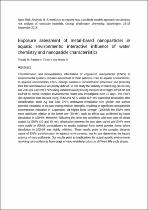 ResearchSpace
ResearchSpace
Exposure assessment of metal-based nanoparticles in aquatic environments: interactive influence of water chemistry and nanopaticle characteristics
JavaScript is disabled for your browser. Some features of this site may not work without it.
- ResearchSpace
- →
- Research Publications/Outputs
- →
- Conference Publications
- →
- View Item
| dc.contributor.author |
Thwala, Melusi

|
|
| dc.contributor.author |
Radebe, N

|
|
| dc.contributor.author |
Tancu, Y

|
|
| dc.contributor.author |
Musee, N

|
|
| dc.date.accessioned | 2014-12-22T07:31:52Z | |
| dc.date.available | 2014-12-22T07:31:52Z | |
| dc.date.issued | 2014-09 | |
| dc.identifier.citation | Thwala, M., Radebe, N., Tancu, Y., and Musee, N. 2014. Exposure assessment of metal-based nanoparticles in aquatic environments: interactive influence of water chemistry and nanopaticle characteristics. In: Nano Risk Analysis II: A workshop to explore how a multiple models approach can advance risk analysis of nanoscale materials, George Washington University, Washington, 15-16 September 2014 | en_US |
| dc.identifier.uri | http://hdl.handle.net/10204/7819 | |
| dc.description | Nano Risk Analysis II: A workshop to explore how a multiple models approach can advance risk analysis of nano scale materials, George Washington University, Washington, 15-16 September 2014 | en_US |
| dc.description.abstract | Transformation and bioavailability information of engineered nanoparticles (ENPs) in environmental systems impedes assessment of their potential risks to aquatic environments. In aqueous environments ENPs undergo numerous transformation processes; and presently their fate and behaviour are poorly defined. In this study the stability of naked Ag (40-60 nm) and ZnO (10-130 nm) ENPs using standard toxicity testing medium at strengths of 50HM and 100HM to mimic complex environmental water was investigated over 15 days. The ENPs size dynamics were tracked using TEM and NTA whilst ICP-MS quantified dissolution after ultrafiltration. Both Ag and ZnO ENPs underwent remarkable size growth and surface potential variations in the two testing medium strengths, resulting in significant nanoparticles concentration reduction in suspension. At higher ionic strength (100HM) the ENPs were more stabilized relative to the lower one (50HM), such an effect was confirmed by lower dissolution in 100HM. However, following the same test conditions with two sizes of citrate coated Ag ENPs (10 and 40 nm); dissolution between the two sizes varied and ENPs were more stable in 50HM, contradictory to results obtained from naked powder forms where dissolution in 100HM was highly inhibited. These results point to the complex dynamic nature of ENPs transformation in aqueous environments; that in turn determines the hazard potency of nano-pollutants. Our results point to implications for actual aquatic environments receiving nano-pollutants from usage of nano-enabled products at different life cycle phases. | en_US |
| dc.language.iso | en | en_US |
| dc.relation.ispartofseries | Workflow;13837 | |
| dc.subject | Nanoparticles | en_US |
| dc.subject | Water chemistry | en_US |
| dc.subject | Engineered nanoparticles | en_US |
| dc.subject | ENPs | en_US |
| dc.subject | Aqueous environments | en_US |
| dc.title | Exposure assessment of metal-based nanoparticles in aquatic environments: interactive influence of water chemistry and nanopaticle characteristics | en_US |
| dc.type | Conference Presentation | en_US |
| dc.identifier.apacitation | Thwala, M., Radebe, N., Tancu, Y., & Musee, N. (2014). Exposure assessment of metal-based nanoparticles in aquatic environments: interactive influence of water chemistry and nanopaticle characteristics. http://hdl.handle.net/10204/7819 | en_ZA |
| dc.identifier.chicagocitation | Thwala, Melusi, N Radebe, Y Tancu, and N Musee. "Exposure assessment of metal-based nanoparticles in aquatic environments: interactive influence of water chemistry and nanopaticle characteristics." (2014): http://hdl.handle.net/10204/7819 | en_ZA |
| dc.identifier.vancouvercitation | Thwala M, Radebe N, Tancu Y, Musee N, Exposure assessment of metal-based nanoparticles in aquatic environments: interactive influence of water chemistry and nanopaticle characteristics; 2014. http://hdl.handle.net/10204/7819 . | en_ZA |
| dc.identifier.ris | TY - Conference Presentation AU - Thwala, Melusi AU - Radebe, N AU - Tancu, Y AU - Musee, N AB - Transformation and bioavailability information of engineered nanoparticles (ENPs) in environmental systems impedes assessment of their potential risks to aquatic environments. In aqueous environments ENPs undergo numerous transformation processes; and presently their fate and behaviour are poorly defined. In this study the stability of naked Ag (40-60 nm) and ZnO (10-130 nm) ENPs using standard toxicity testing medium at strengths of 50HM and 100HM to mimic complex environmental water was investigated over 15 days. The ENPs size dynamics were tracked using TEM and NTA whilst ICP-MS quantified dissolution after ultrafiltration. Both Ag and ZnO ENPs underwent remarkable size growth and surface potential variations in the two testing medium strengths, resulting in significant nanoparticles concentration reduction in suspension. At higher ionic strength (100HM) the ENPs were more stabilized relative to the lower one (50HM), such an effect was confirmed by lower dissolution in 100HM. However, following the same test conditions with two sizes of citrate coated Ag ENPs (10 and 40 nm); dissolution between the two sizes varied and ENPs were more stable in 50HM, contradictory to results obtained from naked powder forms where dissolution in 100HM was highly inhibited. These results point to the complex dynamic nature of ENPs transformation in aqueous environments; that in turn determines the hazard potency of nano-pollutants. Our results point to implications for actual aquatic environments receiving nano-pollutants from usage of nano-enabled products at different life cycle phases. DA - 2014-09 DB - ResearchSpace DP - CSIR KW - Nanoparticles KW - Water chemistry KW - Engineered nanoparticles KW - ENPs KW - Aqueous environments LK - https://researchspace.csir.co.za PY - 2014 T1 - Exposure assessment of metal-based nanoparticles in aquatic environments: interactive influence of water chemistry and nanopaticle characteristics TI - Exposure assessment of metal-based nanoparticles in aquatic environments: interactive influence of water chemistry and nanopaticle characteristics UR - http://hdl.handle.net/10204/7819 ER - | en_ZA |





